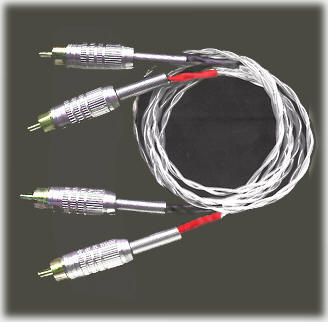|
You are reading the older HTML site Positive Feedback ISSUE 47january/february 2010
The Neoteric Listener...
the Stager Silver Solid interconnects
We don't get much rain in my part of the county, so at the slightest sign of mist, I toss rake, broom, and running shoes aside and revel in afternoons of blessed idleness (I do this in dry weather, too, but my indolence is not quite as guilt-free). The recent steady rain came at a good time, too, because I had already set aside time to write up my review for the Stager Silver Solids pure silver interconnect cable, and inclement weather forms the perfect backdrop for a week's worth of swapping cables and rummaging through the collection. Now I'm no Bob Levi (who is?) but I was excited to try my hand at cable-charming. When the Silver Solids first arrived, it was obvious that the plain shipping envelope and bare-bones appearance of the interconnects set it apart from the look and packaging of my standing cable corps consisting of the Kimber Kable Hero, Harmonic Technology MAGIC Link Two, and Stereolab Reference I-700 RX. These other cords feature ostrich-feather insulation, weapons-grade termination, and Stephen Hawking-designed atomic dispersion that… ok, not really, but there's no doubt that, compared to these other cables, the Stagers do look a little on the plain side. The super silver color is pretty cool, though, and they are easy to plug in and maneuver behind my crowded rack. The simplicity of the Silver Solids makes me think back to my run-in at RMAF with the burliest, manliest beard ever seen west of the Rockies. The Silver Solids are pretty clean shaven, of course, so I'm referring to the man behind the beard who, upon looking at the inch thick interconnect cable trussing up a massive power amp, declared flatly, "Those things just f@#k-up the sound, wire is wire." Looking at my press badge, he went on, "Positive Feedback Online? Yeah, I've read you guys a couple of times." Sensing that the next sentence wasn't likely to be, "I'm your biggest fan," I thanked him for reading, and sidled out of there, leaving the exhibitor to fend off the subsequent harangue about the devious interconnect cartel. The man makes a fair point, though, for who hasn't seen the ad where Company X claims that their fishing line dipped in gold paint trounces the exorbitantly priced bridge cable behemoth? Just as abundant is the plethora of full page ads by the glamour names (well, audiophile interconnect glamour, anyway) that extol the white-paper pedigree and yellow diamond materials of the super cables. Squatting in my leaky shack with music stacked a foot high, staring at the shimmering strands of silver draped behind my rack, I aimed to find out if wire really is just wire. So what do you need to know about the Silver Solids? To start off, here are the essentials from the manufacturer:
Design: Unshielded
symmetrical pair - Ultra low 11 pF/ft. capacitance I like the idea of a money back guarantee, and these cables are easy to ship, so it's pretty much a risk-free venture going in, especially if you're curious about the "silver" sound, which I am. Before doing any critical listening with the Silver Solids, I connected my Arcam 82 compact disc player to the Mystere ia11 integrated powering the Clara Vu 7 loudspeakers and played music from whatever titles I could read without getting my glasses. Right from the start, I noticed an increased midrange presence and overall resolution in comparison to my usual Magic Link Twos.
I typically describe the Link Twos by saying that most cables pour music like a water through a hose, but the Twos open it up like a fire hydrant. This is normally a positive trait, but when I made the unfortunate pairing of the Arcam and the Clara Vu 7s, the Magic Link Twos just produced more of a bad thing. When I used the Silver Solids, the sound still wasn't as good as when the tube amp was used, but it seemed to communicate sound intelligibly so as to be listenable. The initial listening period gave me some indication of the strengths of the Stager interconnects. Just as a caveat, my several weeks of interconnection interludes enable me to speak of my system, my music, and my room only. Cables are fascinating beasts, mercurial to the last, and often changelings for systems met at different places and seasons. After my soggy week's worth listening, many things became clearer, especially the comprehension that cables must be one of two things: transporter or transparent. As I said, my former reference interconnect was the Magic Link Two (retail: $890), which was a paid pig's improvement over my first "serious" cable that I had used for years (and promptly gave to a friend). The Magic Link Two in my system is in the transformer camp, that is, it makes things "better." Last December, however, I won as a raffle prize the Stereolab Reference I-700 RX (retail: $3700, and no it wasn't rigged!). The Reference I-700 RX in my system is supremely transparent to what I imagine the recording would sound like from the master tape. I read over and over about cables being so perfect they disappear from the music chain, but everyone knows that all cables shape the sound in some manner, so invisibility, even from nearly four thousand dollar interconnects, is an illusion. Given that, what did my varying interconnects tell me about the Silver Solids? Playing Lindsey Buckingham's "Never Going Back Again," the Kimber Kable Hero and the Magic Link Two initially seemed to provide a fullness and evenness of sound that is intrinsically appealing. There was no stridency to any of the upper registers, and the bottom notes of the guitar came through forcefully, if indistinct. Other selections only reinforced this notion that music was being "enhanced and refined," not in a pejorative sense, but definitely as an addition. The Hero worked fine, the Link Two better, but it was the Stereolab that made me fully appreciate the difference between something that sounds good and something that sounds right. In a very telling way, the Silver Solids (you remember the Silver Solids, right? This is a review about the Silver Solids...) veer towards the Stereolab's sonic signature. The Stager interconnects reduce the sonic murkiness of the strumming of the guitar by revealing the distinct tones of each string. Likewise, when Buckingham's voice redlines in the middle chorus, the Silver Solids make sure your ears feel the edge of the passage, whereas the Harmonic Technology/Kimber camp made it more palatable by softening the edges, so to speak. That's not to say that the Silver Solids were bright, they just didn't gloss over anything. It wasn't until I played the same passage with the Stereolab (admittedly, a far superior portrayal of the dynamics and tone of both guitar and singer) that I see what the Silver Solids are after. I guess what I'm saying is that I love the impression that the Stereolabs are giving me a precise view of the recording, and the Silver Solids are a step towards that ideal. The sound of the Silver Solids is precise and detailed, and I appreciated these characteristics in all genres of music, whether it was the blistering opening solo of the mono version of the Beatles "Revolution," or the wonderful blend of voices found in K.D. Lang's collaboration with Tony Bennett. I especially like the Silver Solids for those of you with systems that are already in sync with the sound that you enjoy. I'm confident that the Stager Silver Solids will present more musical detail without any detrimental effects, and you can't ask for fairer than that for less than the price of three new vinyl reissues. So does that mean you can simply spend $129 and approach the sound of the Stereolabs? Don't' be silly, but this is not so much apples and oranges, as it is a golden apple and grocery store Red delicious comparison. After enjoying the Silver Solids for several weeks now, however, I feel that they do what I like a cable to do in my system at an exceptionally low price. Again, with a thirty day guarantee, this interconnect merits an audition for all. Stager http://marc.stager.com/silver/intro.htm
|


